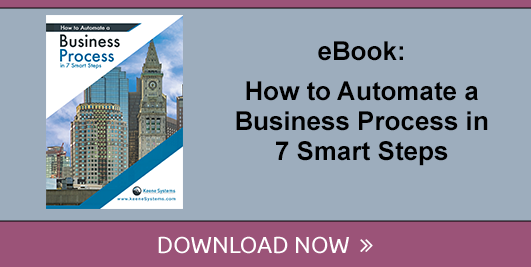Business Process Automation: 7 Steps to Cut Manual Processes
4 min read
Topic:
Automate Business Process
Generally speaking, manual processes are those that still rely on paper forms and "traditional" administrative processes to help information flow freely from one department in a business to another. Are the tasks themselves necessary? Of course - it's just that thanks to modern technology, they don't actually need to be done in those time-consuming and menial ways any longer.
Enter: business process automation, something that allows you to take those manual processes and turn them into a web application, thus freeing up the invaluable time of your employees to focus on those tasks that really need them. Not only is the process flow improved as a result of this, but you also enjoy gains in communication and collaboration, eliminate the risk of data loss, empower productivity and more - all at the exact same time.
Thankfully, using business process automation to streamline these types of manual systems is a lot easier than you may think it is. You just need to keep a few key things in mind along the way.
Harnessing the Power of Business Process Automation: Breaking Things Down
By far, the most important thing to do as you work to adapt business process automation across your own enterprise involves documenting the process in question as thoroughly as possible.
Keep in mind that automation is about not just using a computer to exactly replicate the steps needed to perform a task, but to improve upon them as much as possible. Unless you understand every element required to execute that process, you'll never be able to get to this point.
Next, you'll need to identify the actors in the process - meaning, the people who are actually acting on that data moving forward. Who is responsible for entering the data into the system, for example? Who will eventually consume that data? What are the various roles that each of those actors play when interacting with that data? These are all questions that you'll need to answer before business process automation can begin.
For context, think about things within the example of an accounting firm. Here, an accountant would obviously be in an accounting role whereas a clerk may be in more of a data entry role. Each role has its own view of the data in question, even though the data isn't changing. Depending on your role you may see different dashboards, reports and other elements - and you need to understand all of them to make sure your business process automation efforts go off without a hitch.
Enabling the Flow of Information Throughout an Organization
At this point, you'll need to work to better identify the flow of data through the organization. Yes, you know that it begins at "Point A" and ends at "Point B." But HOW does it get there? What other systems does it interact with? All of this context is important to eliminate issues in the future.
This is why it's so important to understand not only all of the various parts of the process, but who is ultimately interacting with the data as it flows from one department to another. There truly is no "one size fits all" process to what you're trying to accomplish - every business process is unique unto itself and all key stakeholders have a specific role to play. Only by understanding the context surrounding each step in the chain will you be able to develop a new way of doing things that actually improves upon what you had in place before.
Once you know that, you'll be able to translate the process into a series of screens for the collection of data and, more importantly, for the display of data for those who need it to do their jobs. Note that when this is done in an agile development methodology environment, here is where you really start to see genuine improvements in the process in question because stakeholders will be able to see new ways of doing things that were literally not possible before.
Equally important is your ability to implement a trial for testing purposes with users - something that your business process automation partner will be able to take care of. This should use real data in conjunction with existing manual processes, all so that key stakeholders can become educated on the new solution in a way that also makes it easier to flush out errors in the system.
Not only that, but this type of testing process will also go a long way towards increasing user adoption once you have the opportunity to roll things out to the entire organization. Keep in mind that human beings are naturally change resistant, and business process automation represents a pretty big change from the way people are used to doing things. Not only do you need to help someone understand what this web application is capable of, you need them to buy into WHY it's something that they should be embracing to begin with.
By implementing this type of testing process, and by accepting their input in a way that shows you care about their opinion, they'll be able to get a sense for why this is the right move to make at this particular time. Once the testing users are convinced, you'll have a far easier time getting everyone else on board when the larger roll out takes place. It will be very difficult to get to this point if you simply do limited testing and "spring" the new web application on people without warning.

Better Processes Build a Better Business
Finally, you'll want to roll out the solution to all key stakeholders in production - a move that will further validate the performance and accuracy of the web application in question. Once a successful partial roll out has been completed, the system can then be rolled out to the rest of the team that truly need it - all in a way that makes it easier than ever to focus on those core tasks.
But keep in mind, you've done a lot more than just "digitize" that existing process. You've done so in a way that makes it easier for people to do their jobs, leveraging technology to allow them to work "smarter, not harder," so to speak. You've also done so in a way that virtually eliminates human error - something that is unfortunately common in those human-led data entry processes across the board.
All this, and you've also capitalized on legitimate opportunities to improve the process itself - and thus the quality of the work that you're able to deliver to your customers. That's why you need to look at an investment in business process automation for what it really is: an investment in the future success of your organization itself.
In the end, these process automation steps enable literally any business - regardless of industry or size - to significantly improve upon their existing manual processes in a way that also improves the overall efficiency of their teams. Once you add the additional benefits of the agile development process on top of that, you're talking about more than just enhancements in the process itself.
You're also driving better business results at all times, which may very well be the most important benefit of all.
To learn more about the importance of eliminating human error in your operations, please download the eBook titled "How to Automate Business Process in 7 Smart Steps."

